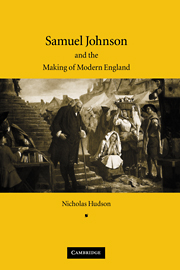Book contents
- Frontmatter
- Contents
- Acknowledgments
- Introduction
- 1 From “rank” to “class”: the changing structures of social hierarchy
- 2 Constructing the middle-class woman
- 3 From “Broad-bottom” to “party”: the rise of modern English politics
- 4 “The voice of the nation”: the evolution of the “public”
- 5 The construction of English nationhood
- 6 The material and ideological development of the British Empire
- Conclusion
- Notes
- Bibliography
- Index
1 - From “rank” to “class”: the changing structures of social hierarchy
Published online by Cambridge University Press: 31 August 2009
- Frontmatter
- Contents
- Acknowledgments
- Introduction
- 1 From “rank” to “class”: the changing structures of social hierarchy
- 2 Constructing the middle-class woman
- 3 From “Broad-bottom” to “party”: the rise of modern English politics
- 4 “The voice of the nation”: the evolution of the “public”
- 5 The construction of English nationhood
- 6 The material and ideological development of the British Empire
- Conclusion
- Notes
- Bibliography
- Index
Summary
JOHNSON AND THE FORMATION OF THE “MIDDLE CLASS”
Georgian England has presented serious problems for modern social historians who wish to understand its systems of social privilege and status. These difficulties have been perhaps particularly unsettling for scholars loyal to the historiographic tradition of Karl Marx, for a rigid division between three classes – aristocracy, bourgeoisie, working class – can hardly do justice to the subtle and changing gradations of eighteenth-century English society. Beneath the 160 or so officially “noble” families in England lay the subtly graded expanse of the “middling orders,” stretching from the great City merchants to the artisans and shop-keepers whose feelings of political exclusion fueled the Wilkite protests of the 1760s. Wilkes had little interest in liberating the poor and lower orders who, as E. P. Thompson acknowledged, themselves seemed more intent on protecting the comforts they enjoyed under the old system of manor and tenant than protesting against the harsh new realities of enclosure in the country and exploitation in the city. It was only after about 1780, with the advent of industrialism and later the panic sown by the French Revolution, that we can speak adequately of an English “class” system. For it was only then that English people themselves began to speak and write a language of “class,” consciously identifying themselves with causes, publications, and organizations formed on behalf of the upper, middle or lower classes.
- Type
- Chapter
- Information
- Samuel Johnson and the Making of Modern England , pp. 11 - 42Publisher: Cambridge University PressPrint publication year: 2003

